Could dinosaurs actually roar? Ancient voice box holds clues.
Loading...
Tyrannosaurus rex may have let out a loud, fearsome roar in the film "Jurassic Park," but paleontologists don't actually know what dinosaurs sounded like – or if they even could make sounds.
Reconstructing the behavior of an animal that has been dead for at least 66 million years is a difficult task, and paleontologists have had little help when it comes to whether or not dinosaurs could vocalize. There is little fossil evidence of a dinosaur voice box.
For clues, scientists have turned to other animals, like birds, which are technically the only living dinosaurs. And buried in a rock from Antarctica, paleontologists have found a tantalizing clue, reported in a paper published Wednesday in the journal Nature.
There are two kinds of voice boxes: a larynx and a syrinx. Almost all living land-dwelling vertebrates vocalize using a larynx, which is a cartilaginous structure that helps produce sounds at the back of the mouth, explains Julia Clarke, a vertebrate paleontologist at the University of Texas at Austin, in an interview with The Christian Science Monitor.
But birds are different. They have a syrinx, a sturdier structure that fits at the base of the animal's windpipe, where it branches to the lungs.
Although paleontologists have found a few dinosaur larynx fragments, they are not definitive proof that the animals could vocalize, Dr. Clarke says, as larynx structures aren't just for vocalization.
But discovering a syrinx, which is only used for sound production, would be, she says.
No fossilized syrinx from the age of the dinosaurs has ever been found – until now.
Clarke remembers the date that she found the oldest known fossilized syrinx: October 24, 2013.
A rock-encrusted duck-like skeleton, discovered in Antarctica a decade earlier, had been in her lab for five years. The animal, Vegavis iaai, lived some 66 to 68 million years ago. Clarke was CT scanning the specimen to create a more detailed picture of the anatomy of an extinct relative of today's ducks and geese.
Clarke had been discussing with physiologists Tobias Riede and Franz Goller, co-authors on her new paper, what would constitute indirect fossil evidence of a syrinx, but she never expected to find a nearly whole one preserved within the rock sitting in her lab.
Previously, the oldest described fossil syrinxes were just a few million years old. Another one, some 50 million years old, had been mentioned in the context of other research but wasn't described until this new study.
Clarke theorizes that even older, more primative syrinxes must have existed. The Vegavis syrinx has a robust shape that would have supported two sound sources, she says, so "this is already a pretty complex syrinx compared to what the earliest form of the syrinx would be."
She and her colleagues suspect the more weakly mineralized, simple syrinx found in paleognath birds (ostriches and cassowaries) today is more like what the ancestral syrinx looked like.
Although this fossilized syrinx is remarkably complex, it is still simpler than some seen in living birds today, Clarke says. Still, she says, "what we see in the fossil is totally consistent with the variety of sounds produced by ducks."
And ducks can produce a range of sounds – mostly quacks, but sometimes they can whistle, too.
So what does this say about what non-avian dinosaurs might have sounded like?
Because no dinosaur-era syrinx had ever been found, many scientists probably assumed that the syrinx, like most soft tissue, simply did not fossilize on those timescales, Clarke says. But now that they know it can fossilize, it suggests that the lack of dinosaur syrinxes is significant.
"There is a very much growing, robust fossil record for dinosaurs," she says. "So why do we not find these structures?"
Clarke has been searching for a non-avian dinosaur syrinx since she discovered Vegavis's voice box in 2013, and has thus far come up with nothing.
She and her colleagues now think that "many dinosaurs did not have a syrinx but in fact vocalized in a manner more similar to that which we see in crocs," she says: "low-frequency booms, maybe using a resonating structure such as an inflated esophagus or something like that, and using the larynx, not a syrinx."
The larynx of a crocodile may not fossilize readily, Clarke suggests, so if non-avian dinosaurs had a similar structure, that might explain why their voice boxes are so hard to find.
Why crocodiles? They're dinosaurs' closest living relatives.
"It's inherently going to be speculative when you talk about dinosaurs communicating," cautions Stephen Nowicki, a biologist and dean at Duke University whose lab studies animal communication, who was not part of the new study.
"Our understanding of evolutionary patterns is constantly changing as we get new information," he tells the Monitor. "A paper like this is telling us something we didn't know before, but it's not necessarily the last word, and that's okay. If somebody finds a treasure trove of fossils, it could change the way we're thinking about this completely."








